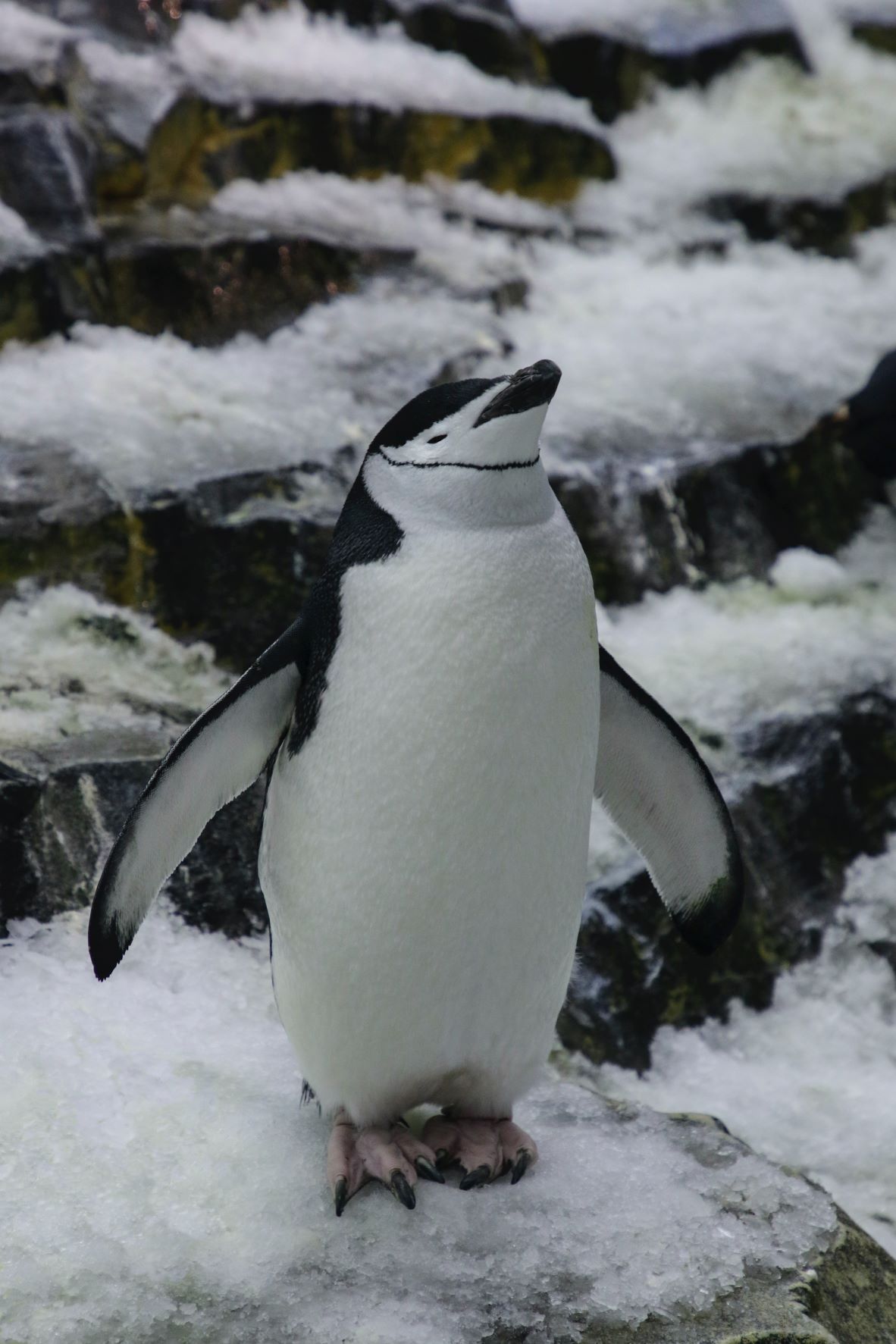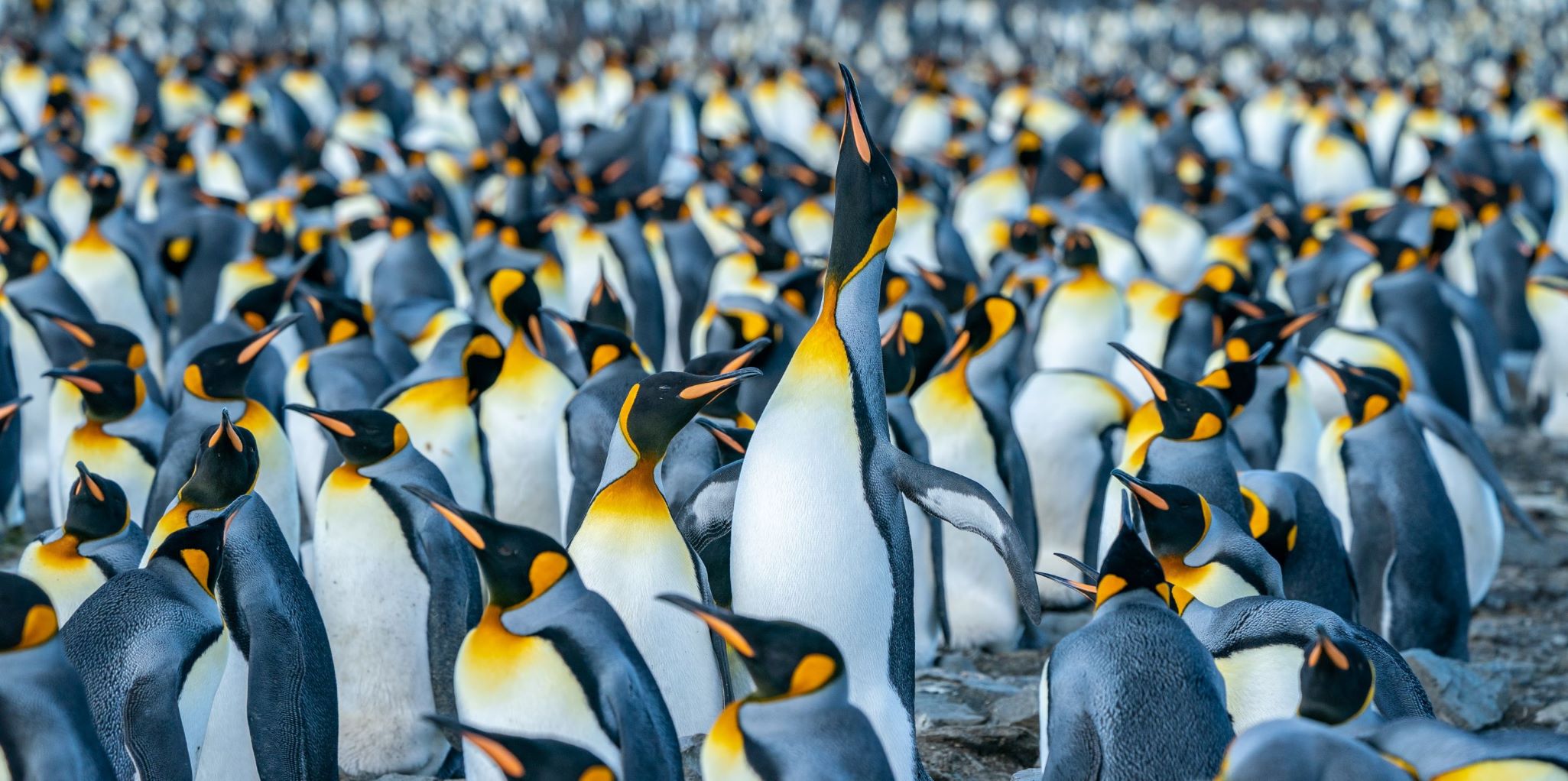
Did you know that January 20th is Penguin Awareness Day? At the Museum of Zoology we have a number of penguins on display, from the handsome emperor penguin standing over a metre tall to the little penguin at closer to 30cm tall, and rockhopper penguin with its plumes of feathers sweeping back on top of its head.
These are just three of the 18 species of penguin alive today. When you think of penguins you may be thinking of Antarctica, but most species are not found on the great southern continent. Emperor penguins are the most southerly breeding birds of all, forming breeding colonies on the sea ice around Antarctica. Adelie penguins are also and Antarctic species, and gentoo, chinstrap and macaroni penguins are known to breed on the northern tip of the Antarctic peninsula. Other penguin species are found further north, on islands and around the coasts of Africa, South America, Australia and New Zealand. Almost all are in the southern hemisphere, but the Galapagos Penguin just slips over into the northern hemisphere.

In this post we will be showing you how to make your own penguin sock puppets out of recycled materials, creating a few of these different penguin species. Remember to ask permission before using any socks or other items to create you puppet!
Rockhopper Penguin Sock Puppet
You will need:
- Black sock
- Scraps of fabric or felt
- Paper and pencil
- Felt tips
- Needle, thread and pins
- Scissors

1. Start with your black sock. If there are any holes that shouldn’t be there, begin by sewing them closed. Now place your hand inside. The sock we used had a heel turn, which we positioned over the knuckles. Then tuck the toe of the sock inwards to make a mouth. Carefully take the sock off your hand – you will be using its shape to make patterns for the beak and tummy.

2. Lie the sock onto a piece of paper flattened down with the top surface facing up. Draw around the end of the sock then lift it off. Now draw a pointed shape for the beak that will be wide enough at the back to cover the width of the sock. To make it symmetrical we folded the paper in half lengthways along the midline of the sock outline and drew the beak shape on one half, cutting out the pattern with the two sides of the paper together.

3. Pin your paper beak pattern to a scrap of felt or stiff fabric and cut out. If you are using a woven fabric, you may need to fold over and sew a hem around the edge or use a little bit of PVA glue to keep it from fraying.
4. Pin your beak to the top surface of your sock and stitch in place, making sure you only sew through one layer of the sock and don’t accidentally sew the two sides of the sock together.



5. To make the beak a bit more beak-shaped, we then folded it in half along its length and put a couple of stitches at the tip.
6. Make a pattern for the tummy in a similar way – drawing around the body of the sock to get an idea of the width of this pattern piece, then drawing out the shape of the white tummy piece, cutting out the pattern piece, pinning it to a scrap of fabric (in this case we used another, pale-coloured sock), and stitching it in place.



7. Cut out two circles for the eyes, and use a black felt tip to draw the pupils. Leave these for a few minutes to dry before sewing them on.



8. We made a rockhopper penguin, with crests of yellow feathers behind the eyes. We made these from narrow strips of scrap fabric in yellows and black, stitching a pile together before attaching behind the eyes. Shorter strips were used to join these two ‘eyebrows’ together into a crest along the line of the knuckles.

Penguin Species
We made a rockhopper penguin, but you might choose a different species for your puppet. They all have very striking markings and make great characters. Pick a penguin and think how you might make their patterns of black, white, orange and yellow with scrap fabrics. We would love to see what you make – check out our online community gallery for information on how to submit your creations to go on the blog!
Northern Rockhopper Penguin, Eudyptes moseleyi
Although slightly larger than its cousin the southern rockhopper penguin, this is one of the smallest species of penguin. Rockhoppers get their name from their agile movements jumping up rocky shores and cliffs. They belong to a group of penguins called the crested penguins, with plumes of feathers behind the eyes and across the head.
Norther rockhoppers breed on islands in the southern Atlantic and Indian Oceans, including Tristan da Cuhna and Gough Island. Breeding colonies are noisy places, with the penguins making barking and braying calls. When not at their colonies, rockhoppers are out at sea, sometimes for as much as six months of the year.
Macaroni Penguin, Eudyptes chrysolophus

Another species of crested pengiun, this one gets its common name from the term used to describe gentlemen of the 18th century who wore outlandish fashions with tall, elaborate wigs. This may all seem very distant from the pasta shapes you may be thinking of when you hear the word ‘macaroni’, but they are not unrelated. It is thought that the macaronis of the 18th century got their name from their taste for the pasta they developed when on the Grand Tour of Europe.
Macaroni penguins are a little larger than rockhoppers, and are one of the most numerous species of penguin with a population of over 11 million. They breed on rocky islands and coasts. Crested penguins like the Macaroni and rockhopper have an unusual habit of laying two eggs – an initial, small egg that doesn’t hatch, and a second, larger egg that does. It is still unknown why this first egg is laid.
Emperor Penguin, Aptenodytes forsteri
The emperor penguin is the largest of all living penguin species, standing to a height of 120cm. These birds really are a species of the Antarctic, breeding on the sea ice surrounding the continent of Antarctica, and rarely straying out of Antarctic waters. They have an extraordinary ability to cope with the harsh Antarctic winter. To give their chicks enough time to develop during the summer, eggs are laid in the winter and given to the male to look after while the female travels back to the sea over many miles of sea ice to feed. The males huddle together in their colony, eggs on their feet to prevent them from freezing on the ice, and withstand the high winds and temperatures as low as -50oC waiting for the females to return. The birds will shuffle around in the huddle to make sure none are on the outer edges and getting cold for too long.
King Penguin, Aptenodytes patagonicus

The patches of yellow and orange on the head and neck make the adults some of the most colourful penguins today. Their chicks look very different, covered with fluffy brown feathers instead.This species is a close relative of the larger emperor penguin, but live and breed on subantarctic islands such as South Georgia, the Falklands and Macquarie Island. Here they can form huge colonies of up to 100,000 breeding pairs. Colonies are occupied all year round by breeding birds and chicks, but non-breeding adults may be found further afield to find more abundant sources of food.
Adelie Penguin, Pygoscelis adeliae

Adelie penguins are smart-looking birds with black and white feathers and a white ring around the eye. They are entertaining to watch, with a bold, curious nature and tendancy to stand up to predators larger than themselves.
Alongside the emperor penguin, Adelies are the other truly Antarctic penguin species. Unlike emperor penguins, they lay their eggs in the Antarctic summer, building a nest of stones on land and raising their chicks in time for them to head out to sea in March to escape the extreme cold of the winter.
Gentoo Penguin, Pygoscleis papua

Gentoo penguins can be recognised by their white patches above the eyes and bright orange/red beak. This is the third largest species of penguin alive today, after the emperor and king penguins. They breed mainly on subantarctic islands like South Georgia and the Falklands, and like Adelie penguins they build a nest out of small stones or other materials. Gentoo penguins are fast swimmers, reaching up to 36km/hr. They tend to feed relatively close to shore, diving to catch fish, squid and crustaceans to eat.
Chinstrap Penguin, Pygoscelis antarcticus

The band of black feathers under the chin in contrast with the white face of these penguins gives them their name. Breeding colonies of this species can be enormous – it is recorded that on the island of Zavodovski in the South Sandwich Islands is home to a colony of around 1 million breeding pairs of chinstrap penguins. They choose steep, often rocky slopes, building nests on the ground from stones.
Chinstrap penguins feed largely on krill as well as small fish and squid. They will go out foraging at night as well as during daylight hours.
Humboldt Penguin, Spheniscus humboldti
This species of penguin is found along the Pacific coast of South America, particularly Chile and Peru. They have a more complex pattern of black, white and grey feathers than the Pygoscelis species described above, with a white band behind a black face, and a black band of feathers running across a white chest. Similar patterns are seen in the three other species of banded penguin: the Magellanic penguin (Spheniscus magellanicus) of South America and the Falklands; the African penguin (Spheniscus demersus) and the Galapagos penguin Spheniscus mendiculus). The calls of banded penguins tend to sound like donkeys braying, and are used to identify each other and keep contact with their mates.





